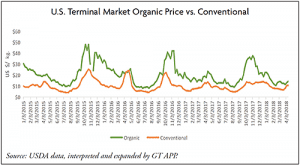Another important trend in the blueberry market is rising demand for organic.
Not surprisingly, organic blueberry pricing in terminal markets has been higher than conventional: in 2015, annual average pricing for organic blueberries was 111 percent higher than conventional; in 2016, pricing was 98 percent higher; and in 2017 it was up by 113 percent.


Organic blueberries have better price elasticity and a tendency to skyrocket during the U.S. low season. The average terminal market price in January 2016 reached $26.28 per kilogram—186 percent higher than conventional and in January 2017 prices reached $27.88 per kilogram, 187 percent higher than conventional.
Prices were even higher in November—for 2016, they reached $31.88, 208 percent higher than conventional, and in October 2017, pricing climbed to $34.65, representing a difference of 164 percent over conventional.
Another factor related to organic blueberries is that terminal market prices during the U.S. high season fall more than in the consumer market, despite prices still being higher than conventional.
In June 2015 the average terminal market monthly price for organic was 120 percent higher than conventional at $11.68 per kilogram; in April of the same year, prices were only 52 percent higher at $19.97 per kilogram. June 2016 pricing was 56 percent higher at $8.73 per kilogram while April prices were only 9 percent higher than conventional at $23.10. In looking at 2017, May prices were 52 percent higher with a terminal market price of $14.23 per kilogram.
Domestic or imported, conventional or organic, highbush or low—however consumers prefer their blueberries, suppliers are leveraging this small berry’s significant health properties to ring up sales. Higher demand continues to push growers throughout North America as well as in Mexico, Central, and South America to plant more acreage and bet on blueberries as a top seller now and in the future.


